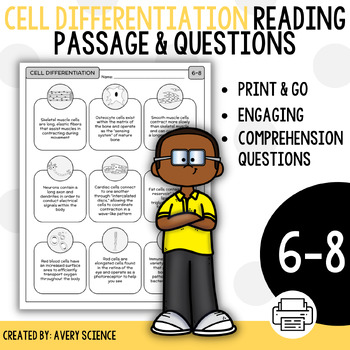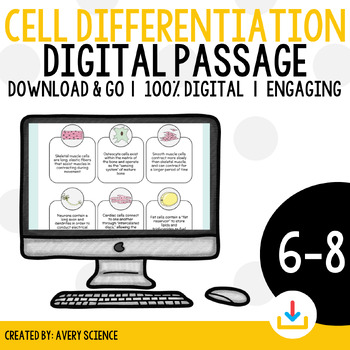Cell Differentiation & Specialization Digital & Print Reading Passage Bundle
- Google Drive™ folder
- Internet Activities

Products in this Bundle (2)
Description
Overview:
Cell differentiation can be a challenging concept for students, especially if they have been looking at traditional cell models and diagrams that only show one type of cell. This introductory reading passage, examples page, and comprehension question assignment is the perfect transition to cell differentiation for your middle school students! Now you can have the best of both worlds with a paper and digital form of this resource bundled together. Virtual snow days don't stand a chance against your cell differentiation lesson! This is an awesome assignment for students if your time is limited for cell differentiation or you aren't able to do a full stem cell project.
Why You'll Love It:
- Digital and print version of this passage
- This resource is designed with middle schoolers in mind and places the focus on cell differentiation.
- This passage connects to the levels of organization. A great review or introduction to this concept, connected with cell differentiation.
- A perfect analogy. Your students will understand differentiation with a clever comparison to different types of jobs.
- Tons of examples with accompanying images. Your students will really understand what cell differentiation looks like. This resource includes an example page with 9 different types of cells along with descriptions about structure and function.
Students Will:
- Read a one-page passage about cell differentiation
- View 9 visual examples with descriptions of different types of cells and how they are differentiated
- Answer five open-ended reading comprehension questions
- Match the cell examples to their functions
Included in this Resource:
- One-page reading passage
- Differentiation example page (9 types of cells included)
- Five comprehension questions
- Matching worksheet
- Digital form with passage and questions
- Answer key
Are you looking for other awesome resources to teach your cells unit? Check out some of my favorites below!
- Cells & Organelles Kaboom! Review Game
- Organelles Cell Analogy Graphic Organizer
- Cells & Organelles Open-Ended Task Cards
- Cells Unit Boosting Bundle
- Organelles Matching Worksheet
- Cellulose Reading Passage & Questions
Terms of Use:
You May:
- Use free and purchased items for your own classroom students, or your own personal use.
- Reference this product in blog posts, at seminars, professional development, workshops, or other such venues, ONLY if both credit is given to myself as the author, and a link back to my TpT store is included in the presentation.
- Purchase licenses at a great discount for other teachers to use this resource.
You May Not:
- Claim this work as your own, alter the files in any way, or remove copyright / watermarks.
- Sell the files or combine them into another unit for sale / free.
- Post this document for sale / free elsewhere on the internet (this includes Google Doc links on blogs).
- Making copies of purchased items to share with others is strictly forbidden and is a violation of the TOU / law.
Clipart and fonts for cover images credit to: Educlips, Hello Literacy, KG Fonts




